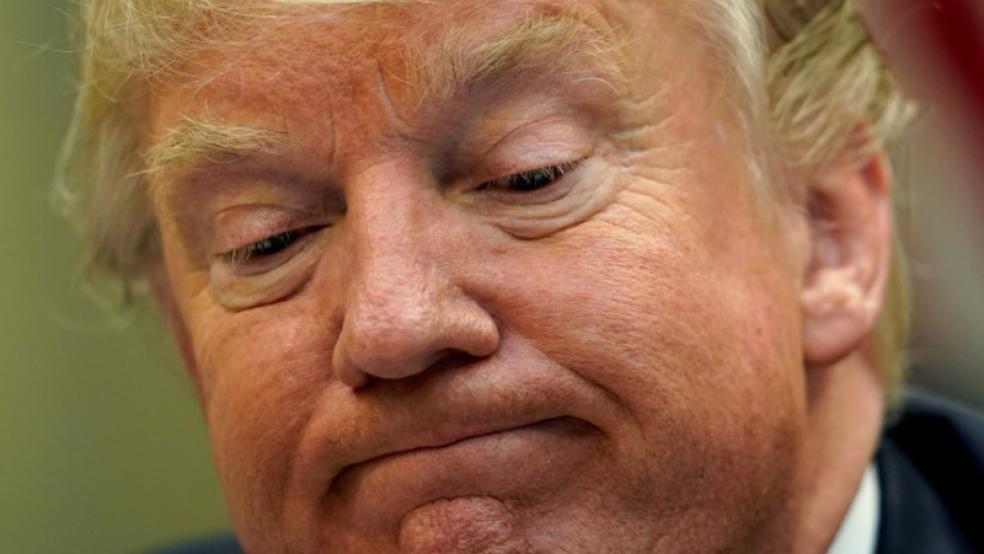- The outlook for the U.S. dollar turned even more bearish on Tuesday after healthcare reform legislation again failed to pass in Congress, casting further doubt on whether the Trump administration will be able to progress to tax reform, infrastructure improvements, and banking deregulation.
The U.S. dollar index that tracks the greenback's strength against major currencies slid to an 10-month low in the wake of setback to President Trump's agenda.
Related: Why Trump Can’t Sell Health Care Reform – and the Price He’ll Pay for It
And with the euro and yen both gaining on the possibility that the European Central Bank and Bank of Japan will raise interest rates later this year as their economies improve, the dollar's decline of the past five months may well continue.
"The prospects for the dollar have turned bearish for the rest of year," said Minh Trang, senior currency trader at Silicon Valley Bank in Santa Clara, California.
A Reuters poll published earlier in July showed a majority of foreign exchange strategists polled by Reuters less bullish on the greenback than at the start of the year.
TRUMP TRADE TARNISHED
After the U.S. elections last November, Wall Street stocks and the dollar gained and bond yields rose on hopes that, with the Republican party controlling both the White House and Congress for the first time since 2006, the new administration would quickly enact big tax cuts and spend on bridges and roads, driving faster economic growth and inflation.
The so-called "Trump trade" has steadily eroded though in the first half of the year as infighting in the Republican party stalled the promised reforms, and the collapse of the latest effort to reform healthcare on Tuesday only served to accelerate the dollar's selloff.
Related: As Health Care Reform Crumbles, House GOP Turns to the Budget and Taxes
“It pushes out the rest of the agenda. It’s hard to do a tax reform in the style that it was campaigned on. The healthcare hurdle pushes everything in Trump’s agenda to 2018,” said Art Hogan, chief market strategist at Wunderlich Securities in New York.
As a result, the U.S. dollar index which tracks the greenback against six major currencies, has fallen 7.48 percent so far this year, making the fall for the year-to-date the biggest since 2002 when it shed 10.87 percent in the same period.
Other indicators are also providing evidence of the market's increasing bearishness on the dollar.
Last week, speculators reduced their net long bets on the dollar to their lowest level since last May, according to the Commodity Futures Trading Commission data.
Traders' three-month bearishness on the dollar versus the euro hit its most extreme since at least 2010 in late June before retreating a bit, Reuters data showed.
ECB AND BOJ ALSO PRESSURE USD
However, prospects for U.S. economic reform are not the only factor seen pressuring the U.S. dollar later this year.
The euro began its latest leg up against the greenback four weeks ago after comments from European Central Bank President Mario Draghi highlighted the euro zone's economic recovery, stoking speculation the ECB may consider paring bond purchases later this year, pushing up euro bond yields and the single-currency.
The euro has gained 10 percent versus the dollar year-to-date, rebounding from a cumulative 23.5 percent drop in the prior three years due to weak economic growth and the region's sovereign debt crisis, Reuters data showed.
Related: The Lesson of the GOP Health Care Collapse: Make America Simpler Again
On Tuesday, the euro climbed to its highest against the greenback since May 2016 after the U.S. Senate failed to bring the healthcare bill to a vote.
The Japanese yen has also advanced against the dollar, gaining over 4.0 percent since January , after the Bank of Japan upgraded its economic outlook, increasing the prospects for paring monetary stimulus in the latter half of 2018.
The greenback has also weakened against the Canadian dollar and the British pound .
The Canadian dollar hit a 15 month high against the U.S. dollar on Tuesday at C$1.2581, bringing its year-to-date gain to 6.0 percent in the wake of the first interest rate rise in seven years by the Bank of Canada last week.
Years of ultra-low interest rates since the 2008 financial crisis had spurred a borrowing binge and helped drive Canadian household debt to record levels in recent years, fuelling a housing boom that has only recently begun to falter.
And analysts forecast the Canadian central bank will raise rates again in October, according to a Reuters poll.
Last week, sterling also reached a 10-month high against the greenback as rising U.K inflation prompted comments from Bank of England officials suggesting interest rates may need to rise, despite slowing economic growth as Britain negotiates its exit from the European Union.
"Clearly, anything that comes along at the moment just corroborates the market's negative attitude on the dollar," said Neil Mellor, senior FX strategist with Bank of New York Mellon in London.
"There's just not enough inflation at the moment. And anything like this (defeat for Trump) is liable to push it lower."




